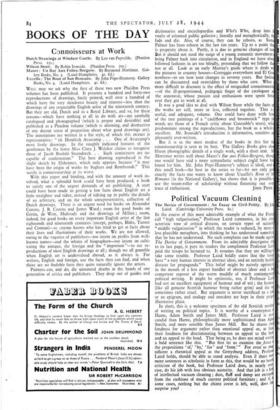BOOKS OF THE DAY
Connoisseurs at Work
Wilson Steer. By Robin Ironside. (Phaidon Press. 2os.) Manet Un Bar Aux Folles-Bergere. By Raymond Mortimer. Gal- lery Books, No. 3. (Lund Humphries. 4s. 6d.)
WELL may we ask why the first of these two new Phaidon Press volumes has been published. It presents a hundred and forty-two reproductions of drawings, finely printed, well over a hundred of which have the very slenderest beauty and interest—less than the drawings of any respectable English artist of the nineteenth century. But they are old, Dutch and in a Royal Library, and so, for these reasons—which have nothing at all to do with art—are carefully catalogued and photographed (which is proper and desirable) and published as a Phaidon volume (which is alarming, and destructive of any decent sense of proportion about what good drawings are). The annotations are written in a flat style, of which this extract is representative: " 16. Hendrick. Avercamp . . . One of Avercamp's most lively drawings. In the roughly indicated features of the gentleman by the horse Miss Clara J. Welcker claims to recognise those of Jacob Roelofz Steenderch. . . Such conjectures are in- capable of confirmation." The best drawing reproduced is the slight sketch by Elsheimer, which only appears because " it may have been the origin of works by Seghers and Rembrandt." This surely is connoisseurship at its worst.
With this paper and binding, and with the amount of work in- volved, what a splendid book could have been produced, a book to satisfy one of the urgent demands of art publishing. A start could have been made in getting a few facts about English art a little straighter and tidier, instead of tidying up in public the details of an arbitrary, and on the whole unrepresentative, collection of Dutch drawings. There is an urgent need for books on Alexander Cozens, J. R. Cozens and James Ward ; room for good books on Girtin, de Wint, Mulready and the drawings of Millais ; room, indeed, for good books on every important English artist of the late eighteenth and nineteenth centuries (except, perhaps, Blake, Turner and Cotman)—as anyone knows who has tried to get at facts about their lives and illustrations of their works. We are not allowed, owing to the vagaries of publishers—too intent on profits from well- known names—and the whims of biographers—too intent on culti- vating the antique, the foreign and the " important "—to see re- productions of most English drawings at all ; though we all grumble when English art is undervalued abroad, as it always is. For writers, English and foreign, use the facts they can find, and when there are no findable facts they quite naturally ignore the artists.
Painters. can, and do, die unnatural deaths at the hands of one generation of critics and publishers. They drop out of guides and
dictionaries and encyclopaedias and Who's Who, drop into vaults of ashamed public galleries ; literally and metaphorically, fade and die. Also, of course, they can be reborn, as Sam Palmer has been reborn in the last ten years. Up to a point di is propriety about it. Partly, it is due to genuine changes of to But it should not need the surge of a young romantic movement bring Palmer back into circulation, and in England we have al followed fashions in art too blindly, pretending that we follow th not at all. Look at an early Murray's guide where it deals the pictures in country houses—Correggio everywhere and El Gr nowhere—to see how taste changes in seventy years. But fashi can be discounted and overridden by those who care. What more difficult to discount is the effect of misguided connoisseurs —of the ill-proportioned, pedagogic finger of the cataloguer the annotator, whose passion and enthusiasm were 'spent bef ever they got to work at all.
It was a good idea to deal with Wilson Steer while the facts the works are still, more or less, collected together. This is useful, and adequate, volume. One could have done with fe of the tree paintings of a " cauliflower and broomstick " type words are those of a French critic about Constable's trees), whi predominate among the reproductions, but the book as a whole excellent. Mr. Ironside's introduction is informative, sensitive pleasantly over-written.
But it is in the most modest of the books in this list connoisseurship is seen at its best. The Gallery Books .give a fifteen photographic details of a single work, with a short text. A Mortimer writes well about Manet's Bar aux Folies-Bergere, thou one would have said a more sympathetic subject cold have b found for him. Mr. John Pope-Hennessy's subject is ideal, and this small book—the best in the series so far—he not only gir exactly the facts one wants to know about Uccello's Rout of S Romano (in the National Gallery), but shows that it is possible use the steam-roller of scholarship without flattening out es


























 Previous page
Previous page